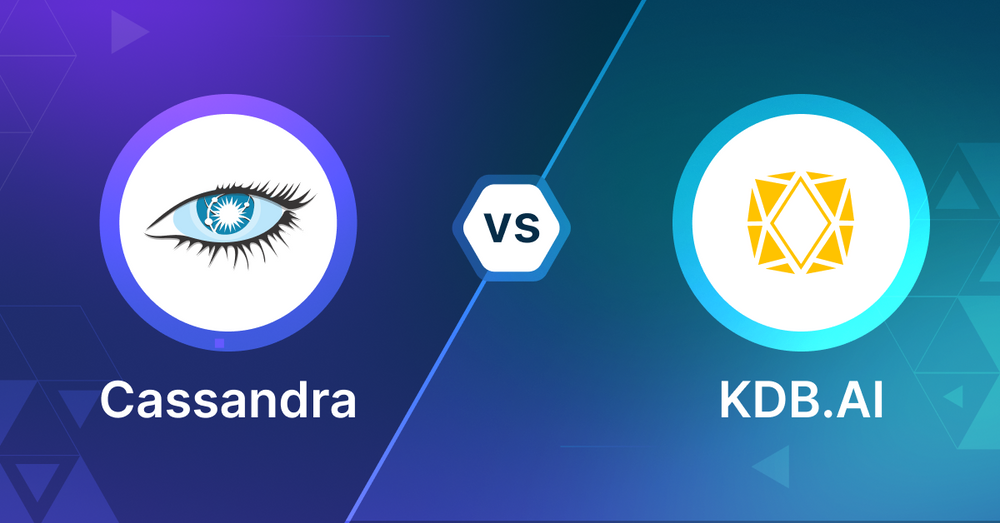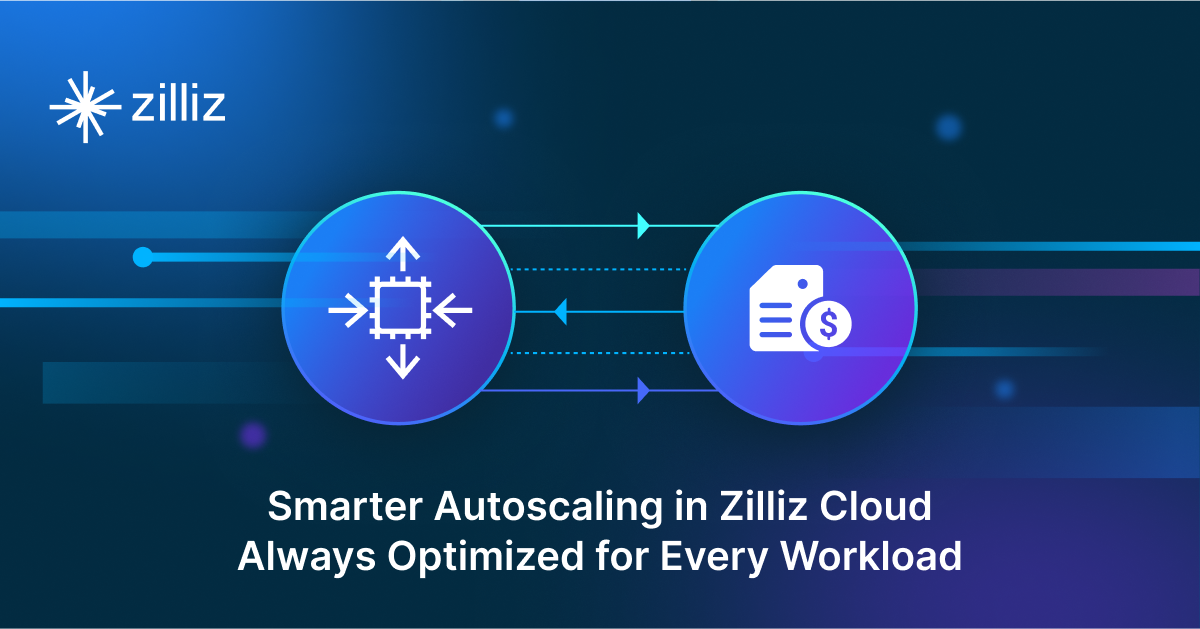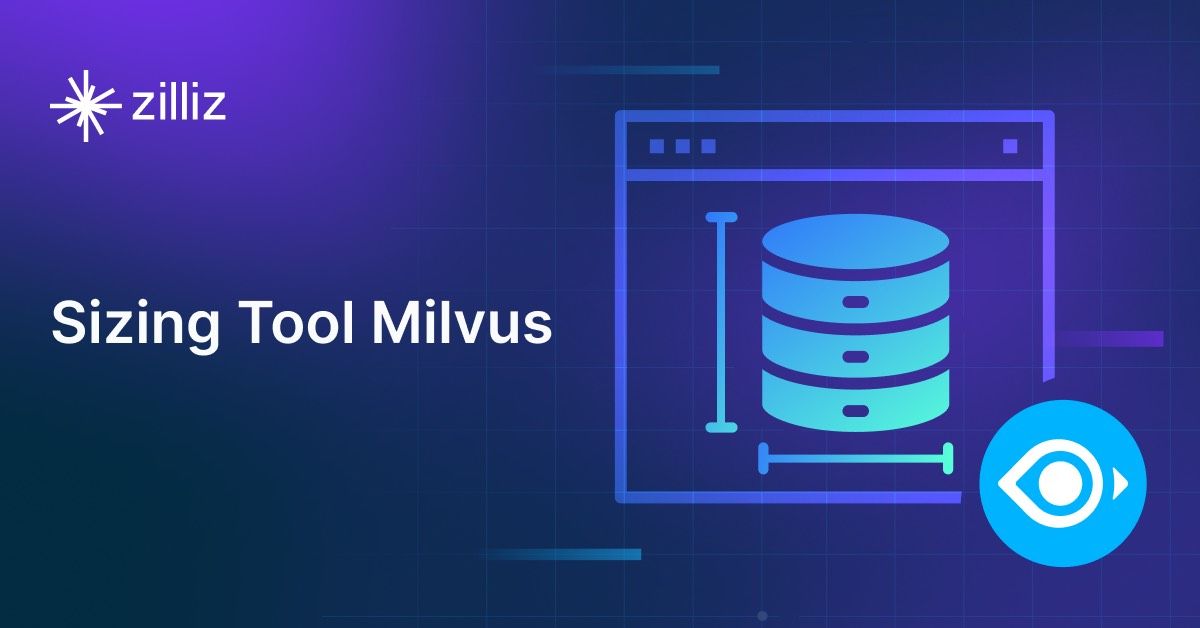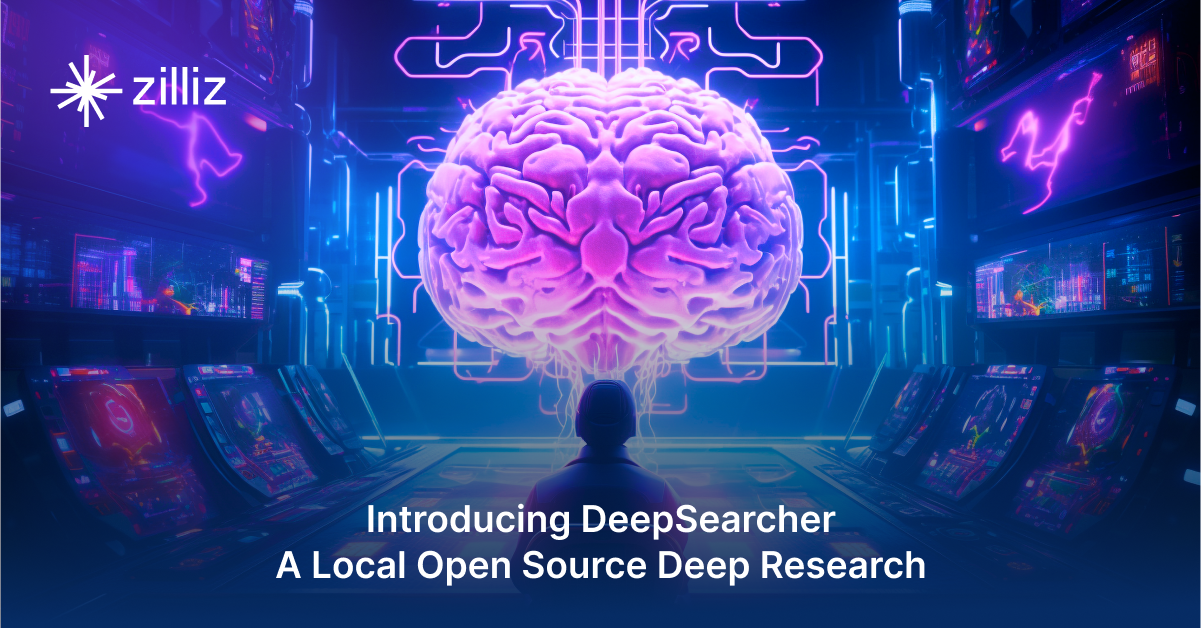Apache Cassandra vs. Kdb: Choosing the Right Vector Database for Your AI Applications

As AI-driven applications become more prevalent, developers and engineers face the challenge of selecting the right database to handle vector data efficiently. Two popular options in this space are Apache Cassandra and Kdb. This article compares these technologies to help you decide on your vector database needs.
What is a Vector Database?
Before we compare Apache Cassandra and Kdb, let's first explore the concept of vector databases.
A vector database is specifically designed to store and query high-dimensional vector embeddings, which are numerical representations of unstructured data. These vectors encode complex information, such as text's semantic meaning, images' visual features, or product attributes. By enabling efficient similarity searches, vector databases play a pivotal role in AI applications, allowing for more advanced data analysis and retrieval.
Vector databases are adopted in many use cases, including e-commerce product recommendations, content discovery platforms, anomaly detection in cybersecurity, medical image analysis, and natural language processing (NLP) tasks. They also play a crucial role in Retrieval Augmented Generation (RAG), a technique that enhances the performance of large language models (LLMs) by providing external knowledge to reduce issues like AI hallucinations.
There are many types of vector databases available in the market, including:
- Purpose-built vector databases such as Milvus, Zilliz Cloud (fully managed Milvus)
- Vector search libraries such as Faiss and Annoy.
- Lightweight vector databases such as Chroma and Milvus Lite.
- Traditional databases with vector search add-ons capable of performing small-scale vector searches.
Cassandra and Kdb represent different approaches to vector databases. Cassandra is a traditional database that has evolved to include vector search capabilities and Kdb, on the other hand, is a purpose-built time series database with added vector search capabilities.
Apache Cassandra: Overview and Core Technology
Apache Cassandra is an open-source, distributed NoSQL database known for its scalability and availability. Cassandra's features include a masterless architecture for availability, scalability, tunable consistency, and a flexible data model. With the release of Cassandra 5.0, it now supports vector embeddings and vector similarity search through its Storage-Attached Indexes (SAI) feature. While this integration allows Cassandra to handle vector data, it's important to note that vector search is implemented as an extension of Cassandra's existing architecture rather than a native feature.
Cassandra's vector search functionality is built on its existing architecture. It allows users to store vector embeddings alongside other data and perform similarity searches. This integration enables Cassandra to support AI-driven applications while maintaining its strengths in handling large-scale, distributed data.
A key component of Cassandra's vector search is the use of Storage-Attached Indexes (SAI). SAI is a highly-scalable and globally-distributed index that adds column-level indexes to any vector data type column. It provides high I/O throughput for databases to use Vector Search as well as other search indexing. SAI offers extensive indexing functionality, capable of indexing both queries and content (including large inputs like documents, words, and images) to capture semantics.
Vector Search is the first instance of validating the extensibility of SAI, leveraging its new modularity. This combination of Vector Search and SAI enhances Cassandra's capabilities in handling AI and machine learning workloads, making it a strong contender in the vector database space.
Kdb: Overview and Core Technology
KDB is a high-performance database that excels in real-time data processing without needing GPUs. It can handle raw data, generate vector embeddings, store them, and run similarity searches in real time. One of KDB’s key strengths is its multi-modal performance, supporting various data types and use cases. Its approach integrates streaming, embedding generation, vector database, raw data handling, time series, and analytics into a unified solution, greatly simplifying the technology stack for developers and making it adaptable across applications.
KDB incorporates dynamic indexing, which allows developers to dynamically select vector embeddings for similarity search without rigid index restrictions. This leads to faster and more flexible search capabilities. KDB supports re-encoding across datasets, enabling cross-dataset similarity searches by re-encoding and storing raw data with different dimensions. For time-series data, KDB provides unique similarity search capabilities even without embedding generation, offering more versatility to users dealing with both fast- and slow-changing datasets.
Regarding performance, KDB stands out from popular methods like HNSW. It performs searches 17 times faster and uses 12 times less memory than HNSW, particularly for fast-changing temporal data. KDB reduces memory and disk storage by 100x for slow-changing, time-based datasets while accelerating searches by 10x. Combining similarity, exact, and literal searches in a single query ensures query relevance even as content evolves, making KDB an efficient solution for real-time and evolving data.
KDB enhances its vector search capabilities by allowing developers to combine vector similarity searches with traditional database queries. This is achieved through filters, which apply custom constraints based on the search parameters. KDB supports multiple search methods, including Flat and qFlat (both exhaustive searches for exact nearest neighbors), HNSW (a graph-based index for efficient traversal), IVF (cluster-based searches for faster but less precise results), and IVFPQ (a compressed version of IVF for improved memory efficiency and speed). Each method offers unique trade-offs, allowing developers to choose the best approach for their use case.
Key Differences
Search Methodology
KDB and Cassandra differ significantly in their search methodologies. KDB supports multiple vector search algorithms like Flat, qFlat, HNSW, IVF, and IVFPQ, offering a mix of exhaustive and approximate search strategies. This provides flexibility in balancing search accuracy and performance. Cassandra, on the other hand, integrates vector search as an extension through its Storage-Attached Indexes (SAI). While SAI enables vector embeddings and similarity searches, it's not as specialized or varied in search algorithms as KDB. KDB’s dynamic indexing and modular search techniques outperform Cassandra’s more limited, index-based vector search.
Data Handling
KDB excels in handling a wide variety of data, including structured, semi-structured, and unstructured formats. It processes raw data in real time, seamlessly generating vector embeddings and performing similarity searches. KDB’s multi-modal nature allows it to support time-series, streaming, and batch data, making it more versatile. Cassandra is built for large-scale distributed data, primarily structured or semi-structured, with vector embeddings added through SAI. However, vector search is not a core feature of Cassandra, and it may not handle unstructured data and real-time vector search as efficiently as KDB.
Scalability and Performance
Both systems are highly scalable, but they take different approaches. KDB scales by integrating various tasks like embedding generation, search, and analytics in one unified solution, providing faster search performance (17x faster than HNSW) while using less memory. Cassandra relies on its masterless, distributed architecture for scalability, with SAI enabling vector searches at scale. While Cassandra is excellent for general-purpose distributed scalability, KDB’s specialization in vector search and data processing makes it more performant for real-time, high-volume use cases.
Flexibility and Customization
KDB offers superior flexibility in data modeling, queries, and customization. Its dynamic indexing allows real-time adjustments in how vector embeddings are selected for searches, enabling developers to fine-tune performance and precision. It also allows combining vector searches with traditional queries. Cassandra, while flexible in terms of its NoSQL data model, lacks the same level of customization for vector search. SAI provides a straightforward, scalable index for vector data, but it doesn’t match KDB’s ability to customize search methods or query combinations as granularly.
Integration and Ecosystem
Cassandra is well-known for its rich ecosystem of integrations, supporting many big data tools, distributed systems, and cloud platforms. The introduction of SAI can also support AI and machine learning workloads, making it versatile and useful in a broader ecosystem. KDB, while not as widely integrated with third-party tools, focuses heavily on multi-modal data and vector search, fitting well within specialized AI and real-time data processing applications. KDB may provide a more seamless solution for use cases centered on AI-driven tasks.
Ease of Use
Regarding ease of use, Cassandra has a gentler learning curve for developers familiar with NoSQL databases and distributed systems. Its documentation and ecosystem provide solid resources for setup and maintenance. KDB, a high-performance database with more advanced real-time processing features, may have a steeper learning curve, especially for developers unfamiliar with its specific query language or architecture. However, for tasks requiring advanced vector search capabilities, KDB's performance benefits may outweigh the additional complexity.
Cost Considerations
Cost considerations differ based on each system's use cases. With its open-source model and broad adoption, Cassandra has lower operational costs in terms of infrastructure but could become more expensive when scaling SAI for large-scale vector search. KDB, while potentially having higher initial infrastructure costs due to its specialized performance capabilities, can reduce costs significantly by using less memory and storage for high-volume or real-time data applications. For developers needing vector search at scale, KDB may offer better long-term value.
Security Features
KDB and Cassandra offer robust security features, including encryption, authentication, and access control. Cassandra integrates easily with enterprise security protocols, including role-based access control and TLS encryption. KDB also offers encryption and security at various levels, but with its focus on high-performance environments, its security features are optimized for real-time and high-throughput tasks. Both systems are secure, but Cassandra might be more adaptable for enterprises with standard compliance requirements.
When to Choose Cassandra
Cassandra is the better choice for use cases that require handling large-scale distributed data, especially when availability and scalability are key concerns. It shines when you need to store massive amounts of structured or semi-structured data across many nodes, like global applications with high write throughput. With the added vector search capabilities through Storage-Attached Indexes (SAI), it fits AI-driven applications that need basic vector search alongside traditional data queries. Cassandra is ideal for companies looking for a robust, scalable NoSQL database with vector search as an additional feature rather than a core focus.
When to Choose KDB
KDB is the superior choice for use cases that demand real-time data processing and high-performance vector search. It's especially suited for tasks like time-series analysis, financial data, or AI applications requiring dynamic indexing, fast searches, and seamless embedding generation. KDB excels in scenarios dealing with multi-modal data (structured, semi-structured, and unstructured) and need advanced vector search capabilities combined with traditional queries. It’s also the right pick for developers looking to simplify their technology stack, integrating streaming, vector searches, and analytics in one platform.
Conclusion
In summary, both Cassandra and KDB are powerful databases, but their strengths lie in different areas. Cassandra is ideal for large-scale distributed data with basic vector search needs, while KDB excels in real-time data processing and advanced vector search capabilities. Choosing the right technology depends on your specific use case—whether you prioritize scalability and distributed data or high-performance, multi-modal data processing with dynamic search options.
While this article provides an overview of Cassandra and Kdb, it's key to evaluate these databases based on your specific use case. One tool that can assist in this process is VectorDBBench, an open-source benchmarking tool designed for comparing vector database performance. Ultimately, thorough benchmarking with specific datasets and query patterns will be essential in making an informed decision between these two powerful yet distinct approaches to vector search in distributed database systems.
Using Open-source VectorDBBench to Evaluate and Compare Vector Databases on Your Own
VectorDBBench is an open-source benchmarking tool designed for users who require high-performance data storage and retrieval systems, particularly vector databases. This tool allows users to test and compare the performance of different vector database systems such as Milvus and Zilliz Cloud (the managed Milvus) using their own datasets and determine the most suitable one for their use cases. Using VectorDBBench, users can make informed decisions based on the actual vector database performance rather than relying on marketing claims or anecdotal evidence.
VectorDBBench is written in Python and licensed under the MIT open-source license, meaning anyone can freely use, modify, and distribute it. The tool is actively maintained by a community of developers committed to improving its features and performance.
Download VectorDBBench from its GitHub repository to reproduce our benchmark results or obtain performance results on your own datasets.
Take a quick look at the performance of mainstream vector databases on the VectorDBBench Leaderboard.
Read the following blogs to learn more about vector database evaluation.
Further Resources about VectorDB, GenAI, and ML
- What is a Vector Database?
- Apache Cassandra: Overview and Core Technology
- Kdb: Overview and Core Technology
- Key Differences
- When to Choose Cassandra
- When to Choose KDB
- Conclusion
- Using Open-source VectorDBBench to Evaluate and Compare Vector Databases on Your Own
- Further Resources about VectorDB, GenAI, and ML
Content
Start Free, Scale Easily
Try the fully-managed vector database built for your GenAI applications.
Try Zilliz Cloud for FreeKeep Reading

Smarter Autoscaling in Zilliz Cloud: Always Optimized for Every Workload
With the latest upgrade, Zilliz Cloud introduces smarter autoscaling—a fully automated, more streamlined, elastic resource management system.

Demystifying the Milvus Sizing Tool
Explore how to use the Sizing Tool to select the optimal configuration for your Milvus deployment.

Introducing DeepSearcher: A Local Open Source Deep Research
In contrast to OpenAI’s Deep Research, this example ran locally, using only open-source models and tools like Milvus and LangChain.
The Definitive Guide to Choosing a Vector Database
Overwhelmed by all the options? Learn key features to look for & how to evaluate with your own data. Choose with confidence.